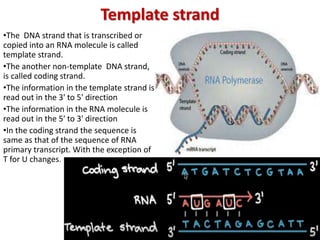5 Key Differences Between Coding Strand and Template Strand

Understanding the Basics of DNA Replication
DNA replication is the process by which a cell makes an exact copy of its DNA before cell division. This process is crucial for the transmission of genetic information from one generation of cells to the next. During DNA replication, the double helix structure of DNA is unwound, and the genetic material is duplicated. The process involves several key enzymes and proteins, including helicase, primase, and DNA polymerase.
The Role of Leading and Lagging Strands

DNA replication occurs in a semi-conservative manner, meaning that the new DNA molecule is composed of one old strand (the template strand) and one new strand (the coding strand). The process begins with the unwinding of the double helix at the replication fork. The leading strand is synthesized continuously in the 5’ to 3’ direction, while the lagging strand is synthesized in short, discontinuous segments called Okazaki fragments.
Coding Strand vs. Template Strand: What's the Difference?
The coding strand and template strand are two complementary strands of DNA that play distinct roles during DNA replication. While both strands are essential for the replication process, they have some key differences:
- Direction of Synthesis: The most notable difference between the coding strand and template strand is the direction of synthesis. The coding strand is synthesized in the 5’ to 3’ direction, while the template strand serves as a template for the synthesis of the new strand in the 3’ to 5’ direction.
- Role in Transcription: The coding strand is also known as the sense strand, as it has the same sequence as the RNA transcript. The template strand, on the other hand, is also known as the antisense strand, as it has the complementary sequence to the RNA transcript.
- Binding of Proteins: The coding strand and template strand have different binding properties for proteins. The coding strand binds to RNA polymerase, which synthesizes the RNA transcript, while the template strand binds to DNA polymerase, which synthesizes the new DNA strand.
- Okazaki Fragments: During DNA replication, the lagging strand is synthesized in short, discontinuous segments called Okazaki fragments. These fragments are synthesized in the 5’ to 3’ direction, and the template strand serves as a template for their synthesis.
- Repair Mechanisms: The coding strand and template strand have different repair mechanisms. The coding strand is repaired through the process of nucleotide excision repair, while the template strand is repaired through the process of base excision repair.
| Characteristics | Coding Strand | Template Strand |
|---|---|---|
| Direction of Synthesis | 5' to 3' | 3' to 5' (template for new strand) |
| Role in Transcription | Sense strand (same sequence as RNA transcript) | Antisense strand (complementary sequence to RNA transcript) |
| Binding of Proteins | RNA polymerase | DNA polymerase |
| Okazaki Fragments | Not applicable | Serves as template for Okazaki fragment synthesis |
| Repair Mechanisms | Nucleotide excision repair | Base excision repair |

In summary, the coding strand and template strand are two distinct strands of DNA that play crucial roles during DNA replication. While both strands are essential for the replication process, they have different characteristics, including direction of synthesis, role in transcription, binding of proteins, Okazaki fragments, and repair mechanisms.
The process of DNA replication is complex and involves multiple enzymes and proteins. Understanding the differences between the coding strand and template strand can provide valuable insights into the mechanisms of DNA replication and repair.
🔍 Note: The coding strand and template strand are often used interchangeably, but they have distinct roles in DNA replication and transcription.
In conclusion, the coding strand and template strand are two complementary strands of DNA that play distinct roles during DNA replication. Understanding the differences between these two strands can provide valuable insights into the mechanisms of DNA replication and repair.
What is the main difference between the coding strand and template strand?
+The main difference between the coding strand and template strand is the direction of synthesis. The coding strand is synthesized in the 5’ to 3’ direction, while the template strand serves as a template for the synthesis of the new strand in the 3’ to 5’ direction.
What is the role of the coding strand in transcription?
+The coding strand is also known as the sense strand, as it has the same sequence as the RNA transcript. It serves as a template for the synthesis of the RNA transcript during transcription.
What is the role of the template strand in DNA replication?
+The template strand serves as a template for the synthesis of the new DNA strand during DNA replication. It is synthesized in short, discontinuous segments called Okazaki fragments.
Related Terms:
- Non coding strand
- Template strand is also called
- Coding strand definition Biology
- Template strand direction
- coding vs template strand dna
- how to determine template strand



